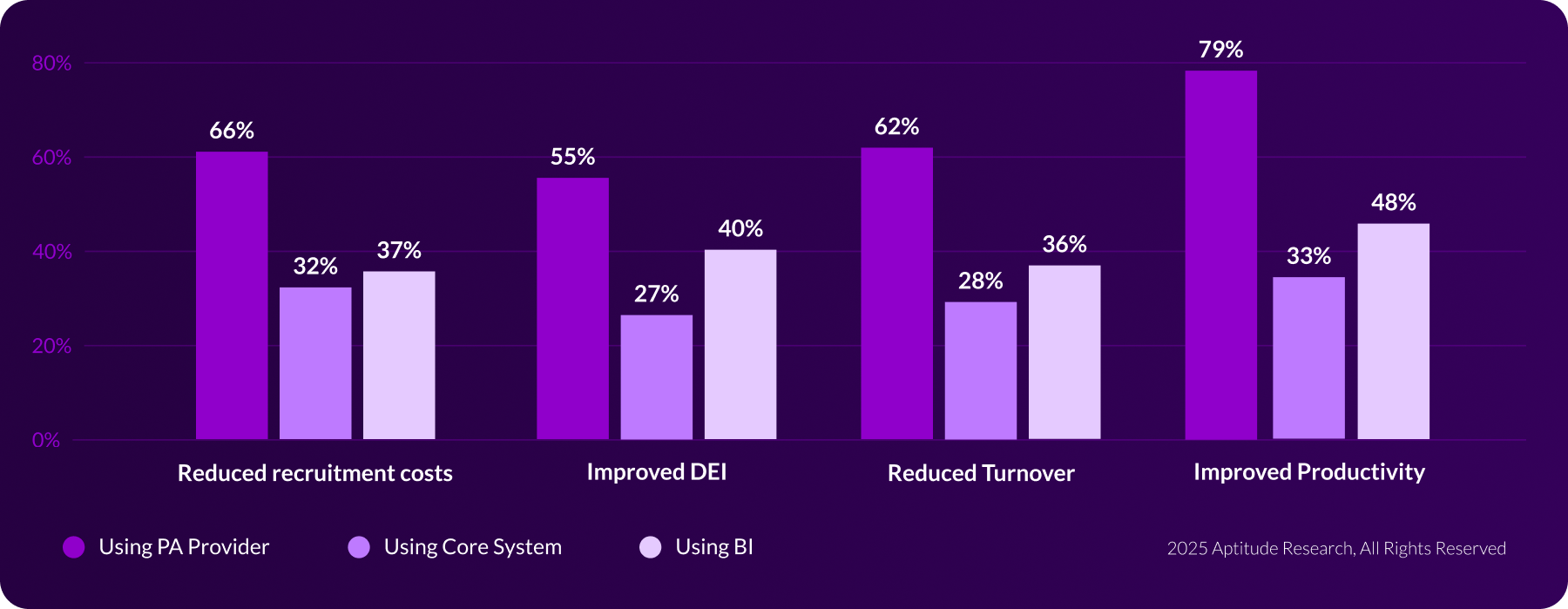Why Your BI Tool Isn’t Telling the Full Story About Your People
(and what it’s costing you without realizing it)
If you lead HR or TA at a small to mid-sized company, chances are your team is spending time pulling data and building reports—often without a dedicated analyst. You’re juggling quarterly reporting, ad hoc leadership requests, and dashboards patched together in spreadsheets.
If your company has access to BI tools like Tableau, Power BI, or Looker Studio, it might feel like you’re a step ahead of the build-everything-manually-in-spreadsheets crowd.
So when “people analytics” comes up, it’s easy to think: We’ve got that covered.
But reporting isn’t the same as insight.
TL;DR:
It’s not about more data reporting. It’s about better decisions.
Your BI tool isn’t wrong – It’s just not enough.
BI tools can show you what happened, but they don’t show you why, or what to do next.
Reporting isn’t the same as insights. BI Tools were designed for data analysts, not talent leaders
Having an internal BI tool doesn’t make it ‘free’ (it can still cost time, speed, clarity, and credibility)
People analytics is not just a reporting tool—it’s designed to deliver ROI specific to HR use cases.
The BI Tool Trap: Measuring What’s Easy, Not What Matters
BI platforms are great for finance and operations. But for HR and TA, they’re often:
Dependent on technical support
Difficult to blend data sources (think: ATS + HRIS + surveys)
Limited to lagging indicators like headcount and turnover
Missing AI-driven insight, diagnostics, and risk forecasting
BI shows you what happened. It rarely tells you why—or what to do next.
That’s why growing teams are turning to purpose-built people analytics. It’s not just about tying data to business outcomes (though your execs want that). It’s about getting clarity, speed, and control—without waiting on someone else to build the dashboard.
What the Research Says
Recent findings from a 2025 Aptitude Research study paint a clear picture. Companies using dedicated people analytics platforms saw dramatically better results than those relying on BI tools:

These numbers reflect more than incremental improvements. They demonstrate that people analytics is not just a reporting tool—it’s a business performance engine. When companies can track, model, and act on talent data in real time, they create smarter hiring processes, reduce costly attrition, and better align their workforce strategy with business goals. The ROI isn’t theoretical—it’s operational.”
— Madeline Laurano, Chief Analyst, Aptitude Research
What most HR and TA leaders actually need isn’t more data—it’s faster, clearer answers to questions like:
Where are we losing our top candidates?
Why are we seeing increased attrition in this department?
Is our onboarding program actually improving first year effectiveness?
What would it take to fill our key roles twice as fast?
If your BI tool can’t answer those questions without a data analyst, it’s not giving you what you need.
If BI Is “Free,” Why Look Elsewhere?
Your BI tool likely doesn’t cost HR anything, since it’s already used by other teams. It might even feel wasteful to look beyond it – especially when your leadership is telling you to make do with the tools you’ve already got.
But here’s what that “free” option could be costing you:
Time. Manual workarounds, spreadsheet stitching, and slow support from shared analysts.
Speed. Delayed action on trends like candidate drop-off or early attrition. When HR requests are a low priority for BI support, getting the data you need is far from “real-time.”
Clarity. Important workforce signals buried in generic dashboards. If your team lacks data expertise, extracting the key takeaways from your dashboards can be confusing.
Credibility. Struggling to turn charts into a clear, consistent story that resonates with leadership and guides executive decisions.
Real Talk from the Front Lines: Why “Access” ≠ “Enablement”
The VP of HR at goeasy Ltd., a mid-sized financial services company, made the case for a people analytics solution.
Our company has Power BI. But it’s not about the platform or the technology – it’s about the service.
I asked our BI team internally, ‘If we want to move all of our HR data and analytics into the centralized system, when would you do it?’ And they replied, ‘We could probably start working on this in about 18 months.’
That’s not even counting the ongoing effort to keep it updated and aligned with our priorities on an ongoing basis.
You might have the tools. But the team and time to make them work for HR? That’s the missing piece.
What to Consider Instead
There’s a range of people analytics solutions—from enterprise-grade to lightweight and tactical. Many offer:
Dashboards made for HR and TA teams
Built-in AI to surface risks and drivers
Cross-system integration without complex setup
Storytelling features to turn data into decisions
💡 But here’s the key: You don’t need a massive investment to get started.
For lean teams, starting small and low-cost is often the smartest way to:
Prove internal value and get buy-in
Avoid wasting resources on overbuilt systems
Focus on your most pressing priorities
See quick wins and build momentum
Whether you’re reducing attrition, improving hiring funnel performance, or trying to speak the language of leadership, a purpose-built, scalable solution gets you there faster.